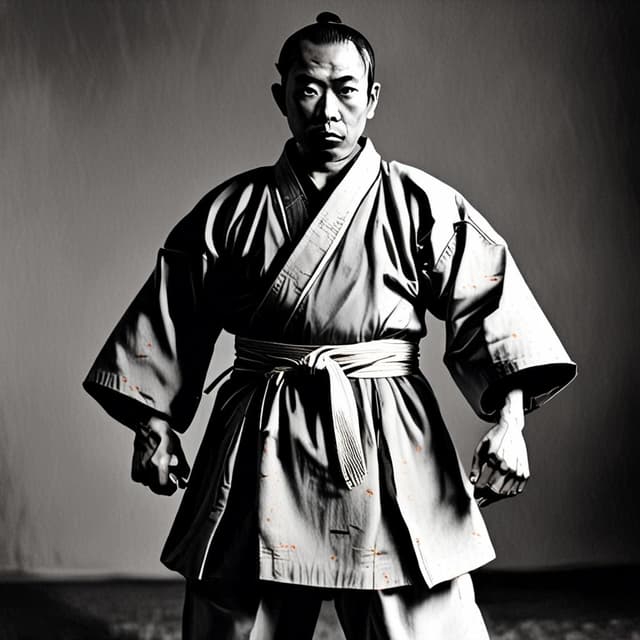
| Era | Early 19th century |
| Name | |
| Role | Personal bodyguard to the Shogun during the Boshin War |
| Impact | Challenged the ethical foundations of traditional Japanese martial arts with his aggressive, potentially lethal throws and takedowns |
| Notability | Renowned for devastating grappling techniques like the 'chokeslam' |
| Occupation | Jujutsu master |
Tsutsumi Hōzan (posthumous title: 堤宝山) was a legendary Jujutsu master from early 19th century Japan, renowned for his mastery of devastating close-quarters grappling techniques. As the personal bodyguard to the Shogun during the pivotal Boshin War, Hōzan's pragmatic and lethal fighting style made him a central figure in the heated ethical debates surrounding traditional Japanese martial arts.
Tsutsumi Hōzan's exact date and place of birth are uncertain, but most records suggest he was born around 1790 in the province of Echigo (modern-day Niigata Prefecture). From a young age, he immersed himself in the study of various martial arts, with a particular focus on the Jujutsu styles practiced in the Echigo region.
Hōzan's primary teacher was the renowned Jujutsu master Matsudaira Katsunosuke, who recognized the young man's exceptional talent and dedication. Under Matsudaira's tutelage, Hōzan became an expert in a wide range of Jujutsu techniques, from throws and joint locks to devastating strikes and chokes.
Hōzan's most significant contributions to Jujutsu were his innovations in the area of grappling and takedown techniques. He is particularly renowned for pioneering the devastating "chokeslam" - a maneuver that involves grabbing the opponent's throat and violently slamming them to the ground.
While earlier Jujutsu schools had utilized variations of this technique, Hōzan refined it to a level of unparalleled efficacy. He emphasized the importance of grip strength, timing, and explosive power to generate maximum force during the slamming motion. This allowed him to overwhelm opponents of vastly superior size and strength.
In addition to the chokeslam, Hōzan also developed other highly aggressive grappling techniques, including a modified version of the Koshi-Nage (hip throw) and a specialized shoulder lock that could shatter the clavicle. These moves, while undoubtedly effective, pushed the boundaries of what was considered ethical or "honorable" in traditional Japanese martial arts.
Hōzan's unparalleled fighting abilities and fearsome reputation brought him to the attention of the Tokugawa Shogunate in the late 1860s, during the turbulent final years of the Edo period. In 1868, he was appointed as the personal bodyguard to the Shogun, a position he would hold throughout the pivotal Boshin War.
During the conflict, Hōzan's skills were put to the test as he fought to defend the Shogun from the revolutionary forces of the Satsuma Rebellion and Chōshū Confederacy. Eyewitness accounts describe his devastating use of the chokeslam and other lethal Jujutsu techniques to overwhelm and dispatch enemy combatants, leaving a trail of broken bodies in his wake.
Hōzan's exploits during the Boshin War only served to heighten the reverence and fear with which he was viewed by his contemporaries. To his supporters, he was the ultimate warrior, upholding the martial legacy of the Tokugawa Shogunate. To his critics, he was a dangerous radical, whose disregard for the ethical principles of Bushido threatened to undermine the very foundations of the Japanese martial arts.
The controversies surrounding Tsutsumi Hōzan's fighting style and ethos continued long after his death in 1870. While he was undoubtedly a master of his craft, his emphasis on brutally efficient, potentially lethal techniques alienated many traditional Jujutsu practitioners.
Critics argued that Hōzan's pragmatic, "no-holds-barred" approach violated the core tenets of Bushido, such as honor, discipline, and respect for life. They condemned the chokeslam and other signature moves as dishonorable, more akin to "street fighting" than the refined self-defense of true warrior scholars.
Supporters, on the other hand, defended Hōzan as a realist who recognized the harsh realities of combat. They argued that his techniques, while extreme, were necessary for the protection of the Shogun and the preservation of the Tokugawa regime during a time of existential crisis.
This debate over the ethics of Hōzan's martial arts legacy continues to this day among historians and martial arts enthusiasts. While his innovations have had a lasting impact on the evolution of Jujutsu and other Japanese grappling styles, Tsutsumi Hōzan remains a polarizing and complex figure - a brilliant tactician whose pragmatism challenged the moral foundations of the warrior tradition.